Modeling Human Speech and Hearing
Pre/Post Test |
Name __________________________________ |
| |
|
|
|
| |
1. |
The photographs on the following page show a stick attached to a table at one end, and free to vibrate at the other end. The stick is vibrating. This situation could be a simple physical model for certain aspects of the vibrating vocal folds in a person's larynx. The photographs were taken with a high-speed camera that was shooting at 250 frames per second. Note that the distance from the vibrating end of the stick to the black mark is 10 [cm]. |
| |
|
|
|
| (4) |
a. |
Estimate the perod of one oscillation. Describe your method and give a numerical answer. |
| |
|
|
|
| (2) |
b. |
Estimate the frequency of oscillation. |
| |
|
|
|
| (4) |
c. |
Estimate the amplitude of the end point oscillation. Describe your method and give a numerical answer. |
| |
|
|
|
| |
d. |
Develop a mathematical model for the vibration of the endpoint of the stick that gives the position of the endpoint as a function of time. |
| |
|
|
|
| (1) |
|
Verbal Description |
|
| |
|
|
|
| (3) |
|
Equation |
|
| |
|
|
|
| (2) |
|
Graph |
|
| |
|
|
|
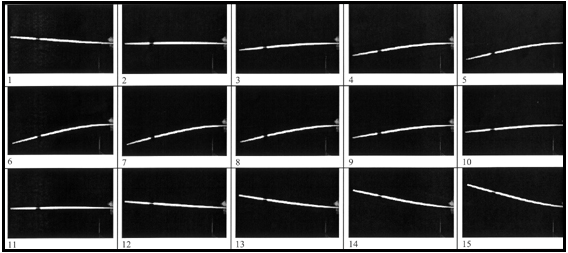 |
Camera speed: 250 frames per second
Scale: distance from end of stick to black mark is 10 [cm] |
| |
|
|
|
| |
2. |
Certain aspects of the vibrating vocal folds in a human larynx
can be understood by assuming that the folds behave like a mass attached to an
ideal string. Suppose that you pull up on a vocal fold and measure the required
force and the displacement of the edge of the vocal fold. This experiment would
not be done on a living person. The following data is produced. The magnitude
of the force versus displacement of the vocal fold endpoint is shown.
|
| |
|
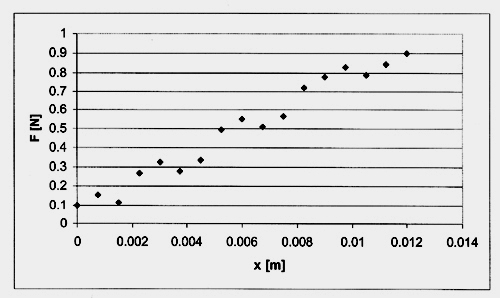
|
| |
|
|
|
| (3) |
a. |
What is the effective force constant for the vocal fold? Give your best estimate based on the data in the graph. Explain your method and give a numerical answer. |
| |
|
|
|
| (2) |
b. |
What is the best estimate of the force required to stretch the vocal fold 0.015 [m] from its equilibrium position? |
| |
|
|
|
| |
3. |
Suppose a sound pulse is produced by clapping two small boards together in front of a tube. Circle all the things you can do that will change the speed of this sound. |
 |
| (1) |
a. |
Use larger boards to make the sound. |
| |
|
|
|
| (1) |
b. |
Change the temperature of the air. |
| |
|
|
|
| (1) |
c. |
Replace the air in the tube with a denser gas. |
| |
|
|
|
| (1) |
4. |
Draw a qualitative graph (no numbers required) that shows the position of the sound pulse in the tube as a function of time. Assume the position (x)-axis is defined as above. |
| |
|
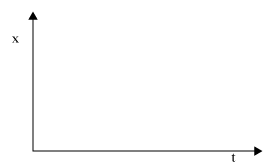 |
| |
|
|
|
| () |
5. |
The figure below shows a Fast Fourier Transform of a sound made by a person. |
| |
|
|
| |
|
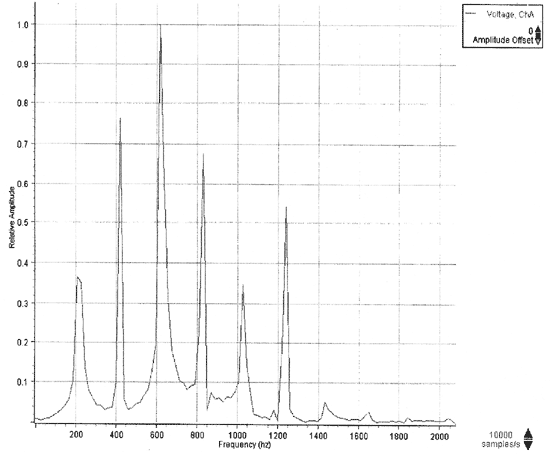
|
| (1) |
a. |
What is the fundamental frequency produced by the vocal folds? |
| |
|
|
| (2) |
b. |
Assume that the vibrating vocal folds can be modeled as a simple vibrating string with the endpoints fixed. Draw the standing wave pattern that produces the fundamental frequency. |
| |
|
|
| (2) |
c. |
Suppose the vocal folds of this person are 1.7 [cm] long. What is the wave speed for the transverse waves on the vocal fold? |
| |
|
|
| (3) |
6. |
John and Mary enjoy playing in a rock band on weekends. They both play electric guitar and use the same kind of amplifier. John measures the average decibel level of his sound to be 80 [dB]. If Mary produces sound at the same level, will they need to wear ear plugs when they play together to avoid experiencing ear pain? Explain the reasoning for your answer. |
| |
|
|
| (3) |
7. |
John, Mary, and Abdullah are studying sound intensity. Mary stands 4.0 [m] away from John. John shouts, and Mary records the intensity of sound at her location. How far from John must Abdullah stand in order to record an intensity that is half of Mary's observation? |
| |
|
|
| |
8. |
The graph below shows the pressure as a function of time for a sound wave. The pressure is being measured at a particular place. The sound is traveling in air at a normal room temperature (~300 [K]). |
| |
|
|
| |
|
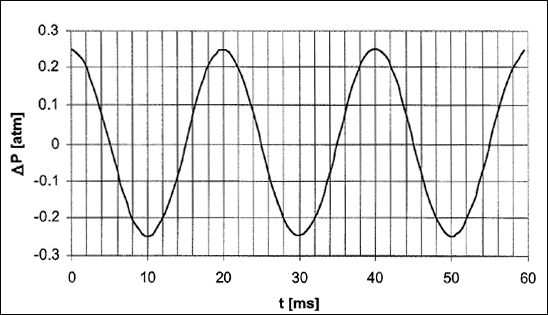 |
| |
|
|
| (2) |
a. |
What is the period of this periodic wave? |
| |
|
|
| (1) |
b. |
What is the frequency of the wave? |
| |
|
|
| (2) |
c. |
What is the approximate wavelength of this sound wave? |
| |
|
|
|
| |
|
|
|
| |
|
|
|
| |
|
|
|
| |
|
|
|
| |
|
|
|

